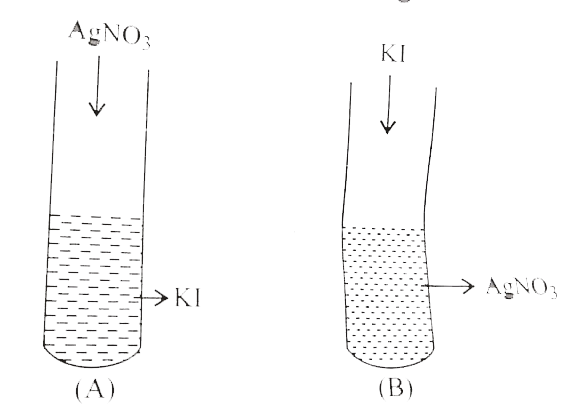What is the origin of charge on colloidal particles?
Step-by-Step Text Solution
Step 1: Understanding Colloidal Particles
Colloidal particles are small particles that are dispersed in a medium. They can acquire electric charge, which is essential for their stability and behavior in solutions.
Step 2: Origin of Charge on Colloidal Particles
The charge on colloidal particles originates from several processes, primarily involving the interaction with ions in the surrounding medium. The main mechanisms include:
1. Dissociation of Surface Molecules: Some colloidal particles develop a charge due to the dissociation of molecules on their surface. For example, in a soap solution, sodium palmitate (C15H11COONa) dissociates into C15H11COO⁻ (anions) and Na⁺ (cations). The anions tend to aggregate due to weak attractive forces, leading to a net negative charge on the colloidal particles.
2. Frictional Electrification: When the dispersed phase particles rub against the dispersion medium, they can gain or lose electrons, resulting in a charge. This process is known as frictional electrification. Both the colloidal particles and the dispersion medium can become charged due to this interaction.
3. Selective Adsorption of Ions: Colloidal particles can selectively adsorb ions from the surrounding solution. For instance, when silver iodide (AgI) colloidal particles are introduced to a solution containing potassium iodide (KI), they may adsorb I⁻ ions, becoming negatively charged. Conversely, if silver nitrate (AgNO₃) is introduced, the AgI particles may adsorb Ag⁺ ions, resulting in a positive charge.
Step 3: Examples of Charge Origin
- Example 1: In soap solutions, the dissociation of sodium palmitate leads to a negative charge on colloidal particles due to the presence of C15H11COO⁻ ions.
- Example 2: Rubbing particles against the dispersion medium can create charges through friction.
- Example 3: The selective adsorption of ions can either increase or decrease the charge on colloidal particles, depending on the ions present in the solution.
Colloidal particles are small particles that are dispersed in a medium. They can acquire electric charge, which is essential for their stability and behavior in solutions.
The charge on colloidal particles originates from several processes, primarily involving the interaction with ions in the surrounding medium. The main mechanisms include:
- Example 1: In soap solutions, the dissociation of sodium palmitate leads to a negative charge on colloidal particles due to the presence of C15H11COO⁻ ions.
- Example 2: Rubbing particles against the dispersion medium can create charges through friction.
- Example 3: The selective adsorption of ions can either increase or decrease the charge on colloidal particles, depending on the ions present in the solution.
Topper's Solved these Questions
- SURFACE CHEMISTRY BOOK - ICSECHAPTER - SURFACE CHEMISTRY EXERCISE - ISC EXAMINATION QUESTIONS
4 Videos
- SURFACE CHEMISTRY BOOK - ICSECHAPTER - SURFACE CHEMISTRY EXERCISE - EXERCISE (PART-II ( DESCRIPTIVE QUESTIONS )) ( SHORT ANSWER QUESTIONS)
81 Videos
- SPECIMEN QUESTION PAPERBOOK - ICSECHAPTER - SPECIMEN QUESTION PAPEREXERCISE - QUESTION
140 Videos
- THE SOLID STATEBOOK - ICSECHAPTER - THE SOLID STATEEXERCISE - MULTIPLE CHOICE QUESTIONS (Assertion-Reason based questions)
10 Videos
Similar Questions
Knowledge Check
Which of the following is not an explanation for the origin of charge on the colloidal particles ?
ADue to frictional electrificationBDue to dissociation of surface moleculesCDue to electrophoresisDDue to selective adsorption of ions
The origin of charge on colloidal solution is
View SolutionA colloidal solution of ferric oxide is prepared by two different methods as shown below.
a. What is the charge on colloidal particles in the two test tubes (A) and (B)?
b. Give reasons for the origin of charge.
View SolutionWhat is the charge on the colloidal particles in the following ?
a. Fe(OH)3 sol
b. As2S3 sol
c. Colloidal sol of sillver
View SolutionWhat will be nature of charge on colloidal particie when FeCl3 is added to excess of hot water ?
View SolutionA colloidal solution of Agl is prepared by two different methods as shown in the figure below:


What is the charge of Agl colloidal particles in the two test tubes (A) and (B) ?
b. Given reasons for the origin of charge.
View SolutionA particle initially moving towards south in a vertically downward magnetic field is deflected toward the east. What is the sign of the charge on the particle?
View Solutionwhich property of colloidal solution is independent of charge on the colloidal particles ?
View Solution
